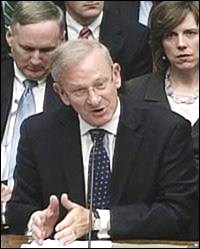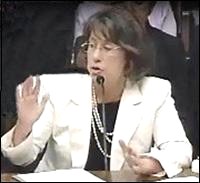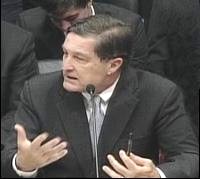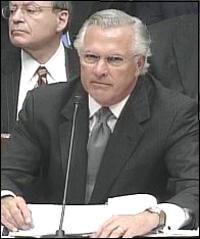By Pam Martens: June 27, 2013
Former Federal Deposit Insurance Corporation Chair, Sheila Bair, was watching the clock on the wall yesterday during her questioning by the House Financial Services Committee on whether the Dodd-Frank financial reform legislation can stop another taxpayer bailout of too-big-to-fail banks. In the midst of the hearing, it was announced that Bair would have to depart at 12 noon. Based on the answers coming from Bair versus the three other witnesses, there was the impression that Bair wanted to beat a hasty retreat to lunch.
The problem comes down to this: Bair and many on the Democrats’ side of the aisle, refuse to acknowledge that their much ballyhooed financial reform legislation passed in July 2010, the Dodd–Frank Wall Street Reform and Consumer Protection Act, is an utter failure in reining in the abuses of the Wall Street behemoths as well as useless in preventing another taxpayer bailout.

Thomas Hoenig, Vice Chair of the FDIC, Testifying Before the House Financial Services Committee On June 26, 2013
Thomas Hoenig, former President of the Federal Reserve Bank of Kansas City and now Vice Chair of the FDIC, told the Committee that the biggest banks are “woefully undercapitalized” and that we have a “very vulnerable financial system.” Hoenig was also a member of the Federal Reserve System’s Federal Open Market Committee from 1991 to 2011. Hoenig is so convinced of the utter failure of Dodd-Frank that he is strongly advocating the restoration of the Glass-Steagall Act which would force the separation of banks holding insured deposits from Wall Street brokerage firms and investment banks.
Richard Fisher, President of the Federal Reserve Bank of Dallas, said “I don’t think we have prevented taxpayer bailouts by Dodd-Frank” and added that the legislation “enmeshes us in hyper bureaucracy.”
The President of the Federal Reserve Bank of Richmond, Jeffrey Lacker, honed in on the core of the problem:
“The Orderly Liquidation Authority of Title II of the Dodd-Frank Act gives the Federal Deposit Insurance Corporation the ability, with the agreement of other financial regulators, to take a firm into receivership if it believes the firm’s failure poses a threat to financial stability. Title II gives the FDIC the ability to borrow funds from the Treasury (specifically, the Orderly Liquidation Fund at the Treasury) to make payments to creditors of the failed firm. The funds are to be repaid from recoveries on the assets of the failed firm or from assessments against the largest, most complex financial companies. While the FDIC is to pay creditors no more than they would have received in a liquidation of the firm, the Act provides the FDIC with broad discretion to pay more. This encourages short-term creditors to believe they would benefit from such treatment and therefore continue to pay insufficient attention to risk and invest in fragile funding arrangements. Given widespread expectations of support for financially distressed institutions in orderly liquidations, regulators will likely feel forced to provide support simply to avoid the turbulence of disappointing expectations. We appear to have replicated the two mutually reinforcing expectations that define ‘too big to fail.’ ”
Bair, on the other hand, is clinging desperately to the deeply discredited illusion that Dodd-Frank can deal with globe-trotting Frankenbanks which are under investigation for rigging everything from Libor, to oil, to foreign exchange currency rates, while preventing the taxpayer from mopping up the next round of financial hubris.
Bair stuck her neck out on a very fragile limb with this testimony:
“The Dodd-Frank Act requirements for the regulation and, if necessary, resolution of LCFIs [large, complex financial institutions] are essential to address the problem of too-big-to-fail and eliminate the need for taxpayer bailouts of failed institutions. I strongly disagree with the notion that orderly liquidation authority (Title II/OLA) enshrines the ‘bailout’ policies that prevailed in 2008 and 2009. Implicit and explicit too-big-to-fail policies were in effect under the legal structure that existed before Dodd-Frank. Dodd-Frank has abolished them. To the extent the problem of too-big-to-fail and risks of taxpayer assistance remain, it is because (1) regulators have more work to do to reduce the risk of an LCFI failure and make sure rules and processes are in place to ensure their orderly liquidation if they do fail; and (2) markets continue to question whether government can and will follow-through on its plan to allow an LCFI to fail without a bailout. I believe we are on the right track for addressing both of these realities, but more can, and should, be done.”
Bair’s self-imposed naiveté ignores four key words essential to the debate. Bair refers to the banks as large, complex financial institutions or LCFIs. The rest of the world thinks of them as SIFIs – systemically important financial institutions.
AIG wasn’t saved by the taxpayer because it was large and complex – it was saved because it had insured billions of dollars in credit default swaps owned by the biggest banks on Wall Street. Its failure would have ricocheted systemically throughout Wall Street. Citigroup wasn’t saved because it was large and complex, it was saved because it held billions of insured deposits and owed money to all the major firms on Wall Street. When one of these giant firms fail, it can’t be walled off. The unknown element of how its losses will bring down other Wall Street banks creates an instant panic and contagion. The idea that there could be an orderly liquidation of one of these firms is so dangerously naïve as to put the entire country at risk, just as we saw in 2008.
As Hoenig told the Committee, “The largest eight U.S. global systemically important financial institutions in tandem hold $10 trillion of assets under GAAP accounting, or the equivalent of two-thirds of U.S. GDP, and $16 trillion of assets when including the gross fair value of derivatives, which is the equivalent of 100 percent of GDP.”
Before the next financial crisis is upon us, Sheila Bair needs to take bold, courageous action and repudiate her trust in Dodd-Frank and cast her lot with those calling for the restoration of the Glass-Steagall Act – the country’s only genuine hope for restoring order to Wall Street.




